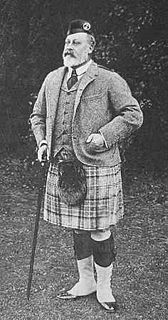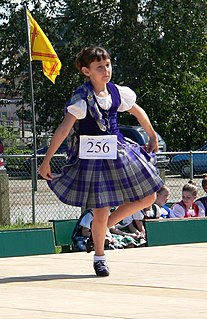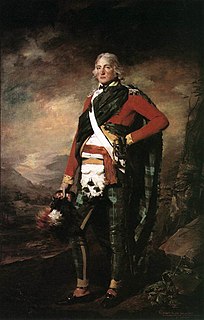
A kilt is a garment resembling a wrap-around knee-length skirt, made of twill woven worsted wool with heavy pleats at the sides and back and traditionally a tartan pattern. Originating in the Scottish Highland dress for men, it is first recorded in 16th century as the great kilt, a full-length garment whose upper half could be worn as a cloak. The small kilt or modern kilt emerged in the 18th century, and is essentially the bottom half of the great kilt. Since the 19th century, it has become associated with the wider culture of Scotland, and more broadly with Gaelic or Celtic heritage.

Perth is a town in Eastern Ontario, Canada. It is located on the Tay River, 83 kilometres (52 mi) southwest of Ottawa, and is the seat of Lanark County.

The 51st (Highland) Division was an infantry division of the British Army that fought on the Western Front in France during the First World War from 1915 to 1918. The division was raised in 1908, upon the creation of the Territorial Force, as the Highland Division and later 51st (Highland) Division from 1915. The division's insignia was a stylised 'HD' inside a red circle. Early doubts about the division's performance earned it the nickname of "Harper's Duds" after the name of its commander, Major-General George Harper.

Tartan Day is a North American celebration of Scottish heritage on 6 April, the date on which the Declaration of Arbroath was signed in 1320. It originated in Canada in the mid-1980s. It spread to other communities of the Scottish diaspora in the 1990s. In Australia, a similar International Tartan Day is held on 1 July, the anniversary of the repeal of the 1747 Act of Proscription that banned the wearing of tartan.

Carry On Up the Khyber is a 1968 British comedy film, the 16th in the series of 31 Carry On films (1958–1992). It stars Carry On regulars Sid James, Kenneth Williams, Charles Hawtrey, Joan Sims, Bernard Bresslaw and Peter Butterworth. It is the second of two Carry On film appearances by Wanda Ventham; and Roy Castle makes his only Carry On appearance, in the romantic male lead part usually played by Jim Dale.

Highland dress is the traditional, regional dress of the Highlands and Isles of Scotland. It is often characterised by tartan. Specific designs of shirt, jacket, bodice and headwear may also be worn along with clan badges and other devices indicating family and heritage.

Highland dance or Highland dancing is a style of competitive dancing developed in the Scottish Highlands in the 19th and 20th centuries, in the context of competitions at public events such as the Highland games. It was created from the Gaelic folk dance repertoire, but formalised with the conventions of ballet', and has been subject to influences from outside the Highlands. Highland dancing is often performed with the accompaniment of Highland bagpipe music, and dancers wear specialised shoes called ghillies. It is now seen at nearly every modern-day Highland games event.
"Highland Laddie", also known as "Hielan' Laddie", is the name of a Scottish popular folk tune "If Thou'lt Play Me Fair Play", but as with many old melodies various sets of words can be sung to it, of which Robert Burns's poem "Highland Laddie" is probably the best known. "If Thou'lt Play Me Fair Play" has been reworked several times since Burns set down his words, Donkey Riding being one variant.

The Highland Fling is a solo Highland dance that gained popularity in the early 19th century. The word 'Fling' means literally a movement in dancing. In John Jamieson's Etymological Dictionary of the Scottish Language, 1808, the Highland Fling was defined as 'one species of movement' in dancing, not as one particular movement. There is some speculation that the first solo Highland Fling dances simply showed off steps that individual dancers preferred in the Strathspey Reel, a social dance.

The aboyne dress is the name given to the prescribed attire for female dancers in the Scottish national dances, such as the Flora MacDonald's fancy, the Scottish lilt, and others. Male dancers wear the kilt for these dances, the kilt being a male garment. There are two versions of the aboyne dress in use. Some consider the aboyne as quite suited to the graceful movements of the National dances.

Trews are men's clothing for the legs and lower abdomen, a traditional form of tartan trousers from Scottish Highland dress. Trews could be trimmed with leather, usually buckskin, especially on the inner leg to prevent wear from riding on horseback.
Gung Haggis Fat Choy is a cultural event originating from Vancouver, Canada. The name is a combination wordplay on Scottish and Chinese words; haggis is a traditional Scottish food while Kung Hei Fat Choi is a traditional Cantonese greeting used during Chinese New Year.

The history of the modern kilt stretches back to at least the end of the 16th century. The kilt first appeared as the belted plaid or great kilt, a full-length garment whose upper half could be worn as a cloak draped over the shoulder, or brought up over the head as a hood. The small kilt or walking kilt did not develop until the late17th or early 18th century, and is essentially the bottom half of the great kilt.

The kilt pin is a piece of jewellery that is usually worn on the lower corner of the outer apron of a kilt. Its function is to prevent the apron falling or blowing open, by adding weight to the outer apron and is commonly seen as a form of decoration. It does not pin the outer apron to the inner fabric, which is a common misconception.
Highland High School was a public high school located in Anderson, Indiana. It was part of the Anderson Community School Corporation. The school consolidated with Anderson High School after the 2009-10 academic year and the former Highland High School building is now used to house Highland Middle School.
A Highland Games event has been held each year since 1956 at Grandfather Mountain, North Carolina. Celebrating the history and culture of Scots in North Carolina, it is among the first and largest modern Highland Games established in the United States. Competitions and displays take place in Scottish styles of piping, drumming, costume, dance, and traditional sports.

Scottish Canadians are people of Scottish descent or heritage living in Canada. As the third-largest ethnic group in Canada and amongst the first Europeans to settle in the country, Scottish people have made a large impact on Canadian culture since colonial times. According to the 2016 Census of Canada, the number of Canadians claiming full or partial Scottish descent is 4,799,010, or 13.93% of the nation's total population. However, some demographers have estimated that the number of Scottish Canadians could be up to 25% of the Canadian population. Prince Edward Island has the highest population of Scottish descendants at 41%.

The Kentucky Scottish Weekend was a regional highland game held annually at General Butler State Resort Park in Carrollton, Kentucky. The weekend's mission was to celebrate the customs and traditions of Scotland. It was held each year on the second full weekend in May. First held in 1983, the weekend celebrated its thirtieth anniversary in 2012, its final year. It was the longest running highland game currently being held in Kentucky at the time it ended. It was held in Carrollton due to that location being nearly halfway between Louisville and Cincinnati. A Kentucky non-profit corporation—Kentucky Scottish Weekend, Inc.—held the event. The weekend was sometimes referred to as "KSW" for short.

"True Scotsman" is a humorous term used in Scotland for a man wearing a kilt without undergarments. Though the tradition originated in the military, it has entered Scottish lore as a rite, an expression of light-hearted curiosity about the custom, and even as a subversive gesture.

The Royal Military College of Canada Bands is the official group of bands of the Royal Military College of Canada. The group is composed of four sections: the brass and reed, the pipes and drums, highland dancers, and choristers. Total band membership consists of 105 Officer Cadets from the college. Officer Cadets in the band practice three days a week in the morning on top of attending their individual full-time university programs.















